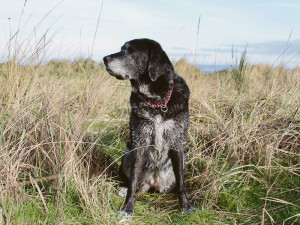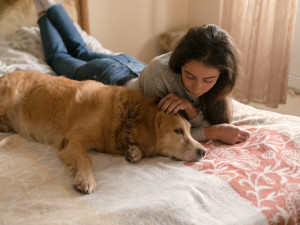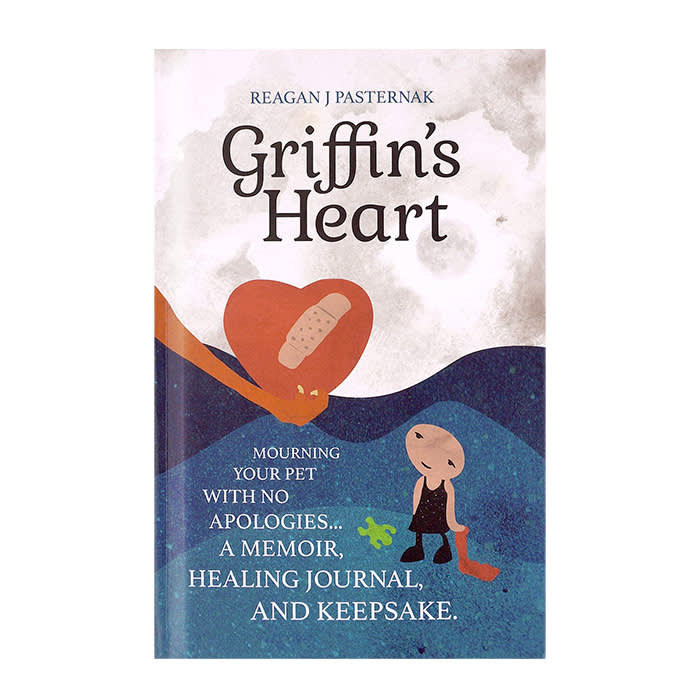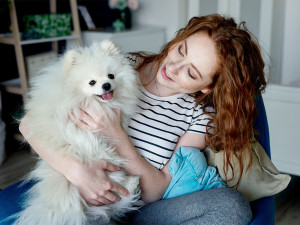“Griffin’s Heart” Should Be Your Go-To Grief Guide
A pet-loss workbook sounds corny, but this gentle, realistic book lets you go at your own pace to heal.
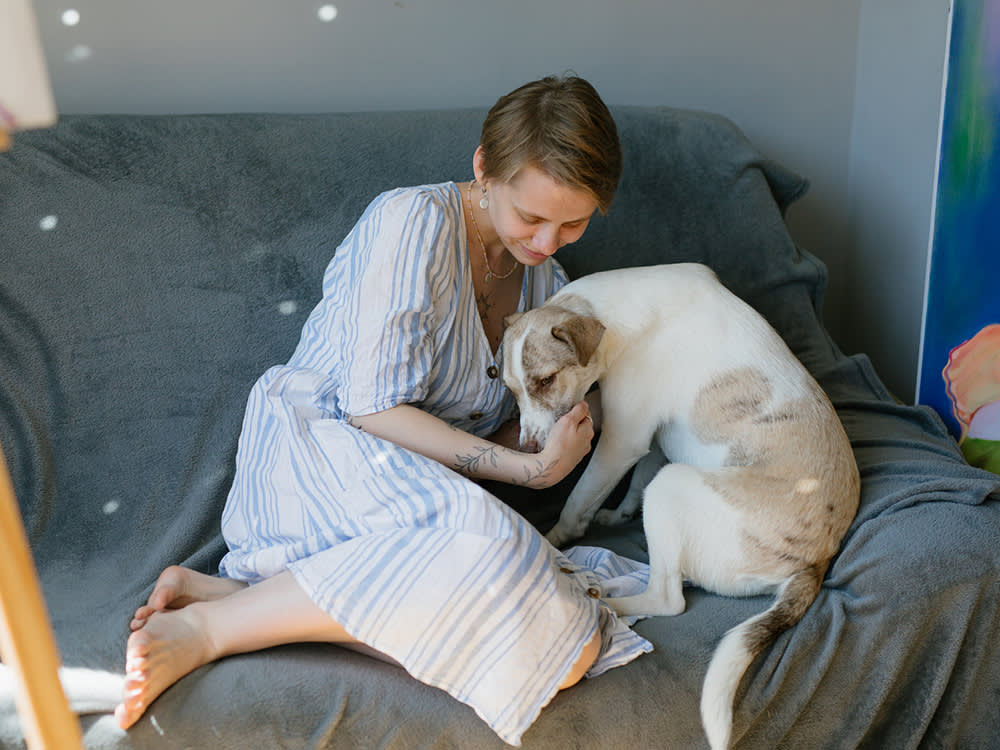
share article
My Mountain Cur, Fletcher, was diagnosed with transitional cell carcinoma (TCC) during COVID lockdown days, when the rest of my life had become its own personal hellscape. I was told by Fletch’s vet that he had about six months to live. But with the help of daily pain meds, a special anti-inflammatory medication with anti-cancer properties, delicious wet food to hide all the pills, and every supplementopens in a new tab or CBD productopens in a new tab I could get my hands on at the local pet store, he lived another 18 months of happy, activity-filled life. He made it to 12 years old. And he loved every second of it.
Fletcher’s last day was in October of 2022, the day after my therapist left on maternity leave. I had anticipated this would happen when she wouldn’t be around to help me with my impending grief, so I had asked her during our last session if she could provide any resources on losing a pet. She got back to me with a recommendation right away: Griffin’s Heartopens in a new tab, a workbook for processing the loss of a pet, by Reagan J. Pasternak. I bought the book immediately, but it stayed on a shelf until recently. I just wasn’t ready to go through the process, the memories, and the loss.
There were so many layers of grief on top of my standard-issue depression and anxiety (hi, I’m a millennial), I didn’t even know where to begin. But I finally printed out a few dozen photos of my beloved pup and cracked the workbook open. Once I did, I couldn’t stop. I want to share that experience with other pet parents who’ve lost their loved one — their “being” as Pasternak refers to them in her writing. As an end-cap to Mental Health Awareness Month (though grief happens all year long), I’m sharing my thoughts and takeaways from Griffin’s Heart. I hope they can help you on your “journey to healing” or to put it more bluntly, to just feel f***ing better.
Introduction: Giving Permission
The first few pages of Griffin’s Heart offer the reader what they really need in the moment: permission to take their grief seriously. Pasternak introduces her own beloved pet’s story, and the struggles she encountered when learning how to best pay tribute to his memory. It offers a welcoming, comfortable sitting room you can dwell in as long as you like before diving into the rest of the workbook and exercises.
Part One: Pain and Acceptance
The first section of Griffin’s Heart provides many prompts inviting the reader to journal about their memories of their pet: How did they look, feel, act? Those first prompts were pretty easy for me. Remembering how Fletcher looked, his little quirks, the essence of his “being” were happy memories for me, and it had been long enough since he died that I could see them that way — even the memory of our last visit to the vet’s office. I wrote about how much he loved to sleep, his fear of flies, and how he got his name.
Things got harder when one of the exercises asked me to “let the pain be” and even thank it. This workbook presents the idea of non-judgmental acknowledgement of our pain and reframes those sad, negative feelings as being good. Pasternak continuously comes back to the idea that some people simply won’t understand the level of grief we may feel after losing a pet, or that it can sometimes be even stronger than when we lose a close family member.
Don’t be afraid to stick up for your grief, if you have the energy; don’t let anyone tell you you shouldn’t be feeling what you’re feeling. I think the most important takeaway from the first section of this workbook is to allow yourself to accept help and feel the emotions that come along with losing someone important to you — after all, Pasternak shares that 38 percent of people surveyed by the Journal of Mental Health Counseling report their pet as being their closest family member.
Part Two: Active Remembrance
Section Two of Griffin’s Heart was probably the most effective for me in my journey. Pasternak begins by telling the reader to “begin to unload the painful memories and then, through the exercises, reinforce the good.” The writing and journal exercises (as well as plenty of spaces for photos — make sure you’ve got a tape dispenser or glue stick handy) in this section revolve around reliving memories. And that doesn’t mean just the good ones.
Exercises include writing about various memories of your pet: their funky habits, their gotcha day, their bedtime routines, and more. Plus, the meditations and healing exercises were incredibly impactful. Pasternak gracefully articulates the process of experiencing your pet’s last days, as well as the grief, mourning, and feelings of guilt that can come along with it. There’s a section on chakras where she shares a “heart-clearing meditation,” in which the reader expresses forgiveness to themselves, others, or the feeling of loss in general. The moment I stated this forgiveness to myself was the moment during this workbook I cried the most. The exercises and reassurances that Pasternak offers after these prompts were incredibly helpful in reframing those memories and helping me to focus on the positive ones.
Part Three: Saying Goodbye
After completing the tough, emotional journey of sections one and two, section three of Griffin’s Heart sets the reader up for what comes next. It encouraged me to let out the hard, hurting, sad feelings I’d been having for the past six months since losing Fletcher and start getting back to remembering him the way he deserves.
In this section, Pasternak shares various cultural practices that can help pet parents get through the loss of their pet and encourages them to think about what’s on the other side of that initial grief. For me, this looked like a new dog who came into my life just three weeks after losing Fletcher. I wasn’t intending on adopting another pet. I meant to take a break (taking care of a sick 12-year-old dog is tough, y’all). But a friend of mine reached out about this goofy, big-eared Cattle Dog mix who was just perfect. He was the polar opposite of Fletch, my independent Hound boy, but he was exactly what I needed. In fact, as I write this, he’s curled up on the couch staring lovingly up at me. Actually, that’s pretty much where he always is. And I can’t help but think Fletcher had something to do with it.
The final pages of the book have the reader write a thank-you note to their pet as a reflection of their lives together and what the animal brought them. The workbook ends with hope and encourages pet parents to express their hopes for the future while also paying their “beings” the respect and homage they deserve.
Final Thoughts on Griffin’s Heart
Fletcher was my first dog. He helped me maintain (at least a semblance of) my sanity through college, grad school, a pandemic, and so much more. Losing him was easily one of the hardest things I’ve ever experienced, and I don’t think I could have even completed this workbook had I tried to start it right away. But after going through the process, I couldn’t recommend it more. If you’ve lost a pet — even if it’s been years — you may find comfort in it, too.

Mollie Jackman
Mollie Jackman is a writer, editor, and graduate of Lindenwood University’s MFA in writing. She’s also a pet parent to a goofy big-eared dog and two brown tabby cats, plus a rotating cast of foster animals. When she’s not reading, writing, or picking up strays, she can be found binge-watching arguably terrible reality TV shows and cooking competitions or rolling around the local skating rink in Columbia, Missouri.
Related articles
![Brown dog with golden eyes leaning on fence]() opens in a new tab
opens in a new tabIs Your Senior Dog Sundowning?
If your senior dog seems confused, restless, or irritable after dark, they may have sundowners syndrome. Here’s how to deal.
![Dog lying on the wood floor is bathed in the sunset light]() opens in a new tab
opens in a new tabWhen Your Dog Gets Alzheimer’s
For dogs with Alzheimer’s, confusion may reign as light falls.
![teach old dog new tricks]() opens in a new tab
opens in a new tabSenior Dogs Need New Tricks to Stay Healthy In Body and Mind
Tuning in to your senior’s needs.
![woman with red hair holds senior Pomeranian dog]() opens in a new tab
opens in a new tabHow to Take Care of a Senior Dog
As dogs age, it’s important to recognize both physical and mental changes they may be experiencing.
![Man in a yellow t-shirt and black pants laying on the couch in an open and airy living room next to his tan and white sleeping dog]() opens in a new tab
opens in a new tabA Walk a Day Keeps the Doggie Dementia Away
A new study finds that physical exercise could keep your dog sharp. Time for walkies!
